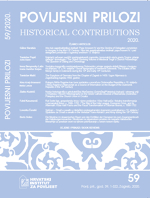Socijalna topografija srednjovjekovnog Dubrovnika: primjer posjeda obitelji Mençe u burgusu na prijelazu 13. u 14. stoljeće
Social Topography of medieval Dubrovnik: The Estates of the Mençe family in Dubrovnik during the 13th and Early 14th Centuries
Author(s): Irena Benyovsky Latin, Ivana Haničar BuljanSubject(s): Archaeology, Architecture, Local History / Microhistory, 13th to 14th Centuries, History of Art
Published by: Hrvatski institut za povijest
Keywords: Dubrovnik; 13th century; 14th century; social topography; Middle Ages; real estates;
Summary/Abstract: The paper provides a detailed overview of the real estate owned by the Mençe family in the burgus of Dubrovnik during the 13th and the first half of the 14th century. In this period, this very branched noble family played a very important role in the social, economic, and political life of the city, as well as the formation of the burgus. The author genealogically follows the estates of all those for whom we have data on real estate in the preserved documents. The expansion of the family shows that marriage strategy was crucial, namely marrying wealthy girls, who brought significant valuable assets in dowry and even real estate in the late 13th century. Another relevant factor for strengthening the family was the number of male descendants, and in case of widowhood, noblemen sought to remarry to a young girl from a family of affiliate interests. These were regularly families that were in some kind of relations – economic, neighbourly, clan, or all three. One can only speculate that the division of land in the burgus, outside the old city walls, had (among other things) to do with the political affiliation of those who largely stayed in Pustijerna and later, with the expansion of the city to the north, moved to a new zone near Pile. During the researched period, the spatially and functionally different suburbs of Dubrovnik – both new and old – were reshaped and unified to form a new city centre. This long and complex process was accompanied by the construction of city walls (in different phases) and changing the old lines of communications in relation to the key points of the city. The transformation of the suburban area into an urban one included, in addition to creating new streets, the division of large blocks into plots for building houses, which resulted in a change in the relationship between the centre and the periphery, as well as the residential mobility of the population. Some of the old noble families, including the Mençe, took advantage of these changes and spread from the old town area to the former suburban gardens. The new estates had multiple functions – they were used for housing, for rent, or to store merchandize they traded in. These functions were subject to change over time and followed the process of urbanization, i.e. the conversion of the burgus into a construction area and an increase in population. The city became the economic centre towards which a wider area gravitated, and not only within the territory of Dubrovnik. Looking at the estates of an elite family and the social topography of the suburbs, as well as the distribution of the estates such an elite family owned, allows us to understand family ties, political orientations, economic activities, marriage strategies, and the way in which the building area in Dubrovnik was structured and used in the period when the city experienced one of the most extensive urban transformations in its history.
Journal: Povijesni prilozi
- Issue Year: 2020
- Issue No: 59
- Page Range: 67-122
- Page Count: 56
- Language: Croatian

